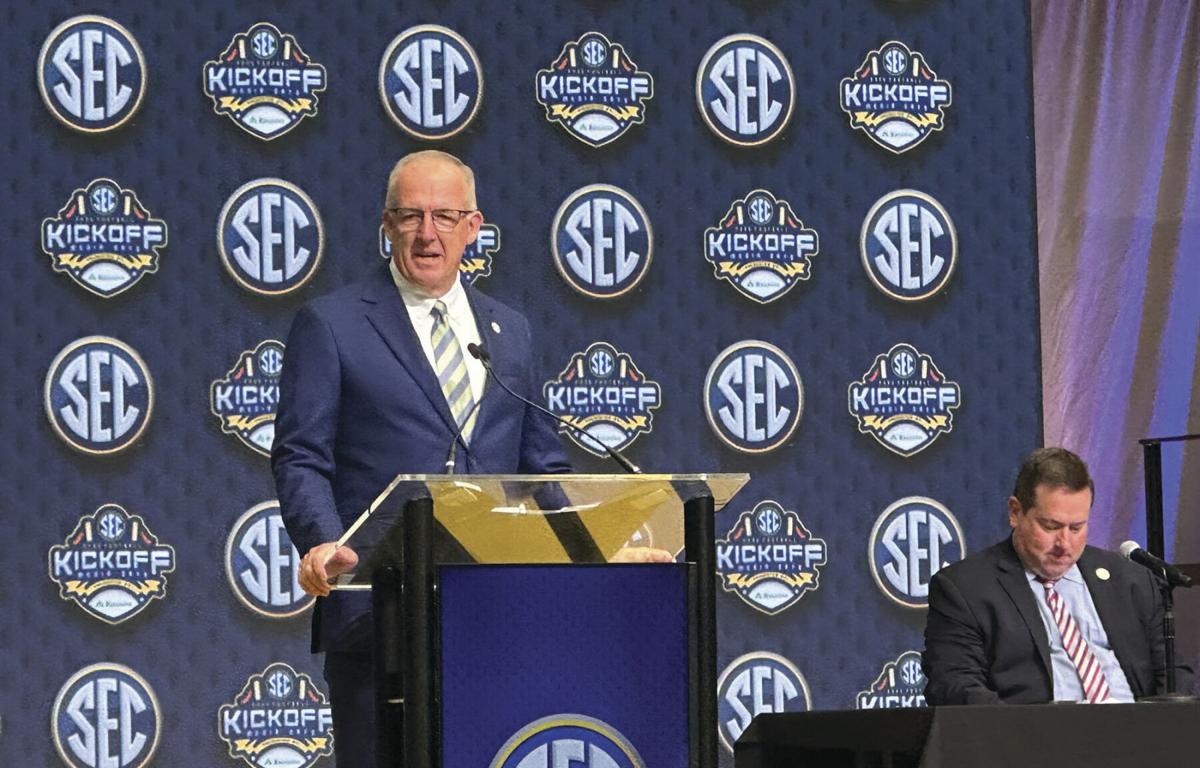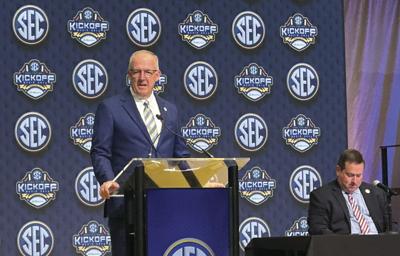Southeastern Conference Commissioner Greg Sankey turned his annual state of the league remarks at SEC media days into a tour de tension, showing off both his conference’s power and awkward position at a pivotal moment in college sports.
“For all of you who like to speculate about superconferences, welcome to one,” Sankey said during his written address to reporters assembled inside the College Football Hall of Fame in Atlanta, which is hosting media days this week.
There aren’t many metaphorical pins with which to poke the collective ego of the SEC when it comes to competitive depth in football and men’s basketball in particular. Even if the past two football national championship games have been played without any SEC teams involved, there’s still a combined might to the conference.
And a commercial might, too, which by the sound of it is arguably more important now.
People are also reading…
Sankey touted a statistic that roughly 40% of linear TV viewership for 2024 college football games was of SEC games. The Big Ten, he said, brought in about 30%.
That’s the kind of odd relationship that college sports’ two biggest conferences have. They’re competing with each other, having swelled in size to “superconference” status. But the Atlantic Coast Conference and Big 12 have grown, too. Together, they’re the Power Four. But really, it’s two and two.
There are fault lines on topics like College Football Playoff expansion. Sankey remains in favor of a “5+11” format for a 16-team bracket that would give automatic bids to the five highest-ranked conference champions and leave the other 11 up to the selection committee, whereas the Big Ten has backed a “4+4+2+2” model that would give more automatic bids to power conferences and leave less up to the committee.
Speaking of postseason expansion: Sankey spoke loosely in favor of bringing the NCAA basketball tournaments up to 72 or 76 teams, though he didn’t cite those exact numbers.
“In general, we are supportive of expanding both the men’s and women’s basketball tournaments,” he said. “Nothing in college basketball is static. Tournament expansion is certainly worth exploring. As last season showed, the Southeastern Conference is going to be fine whether the bracket expands or not.”
What the SEC did last season — 14 of its 16 teams made the men’s field, 10 made the women’s — goes against the argument for the league to be behind it. Does the league really want to reward the team that finished 15th in its men’s hoops standings, 3-15 Louisiana State, with a postseason spot? On the women’s side, should 5-11 Florida have earned a bid?
This is where Sankey’s philosophy seems to diverge from the priorities of fans and coaches. Ask a coach or a fan what they’d like to see changed with college sports and you’re probably going to get a whole laundry list — confusing new compensation rules, the transfer portal, scheduling imbalances — before someone passionately suggests adding four or eight more teams to March Madness.
To his credit, Sankey mentioned the general malaise toward the modern age of college sports in his remarks — “an inventory of all that’s happening,” as he called it.
“We wonder what might be the next state law to be introduced or the next lawsuit,” he said. “We’re interested in litigation that has resulted in individuals being able to participate in college sports well into their mid-20s. That starts to remove opportunities for aspiring high school athletes.”
Sure, that’s a concern for some. Maybe even many. But there’s a tense juxtaposition to that Sankey comment as well: In the media days spotlight, wearing a tuxedo as one of Vanderbilt’s three player attendees Monday was quarterback Diego Pavia. His play style and personality have rejuvenated the Commodores — and his legal victory set off a wave of eligibility-related lawsuits around the country. Nothing comes without a little tension for Sankey these days.
Mizzou, Ole Miss in similar spots
The last time Missouri and Mississippi played each other in football was 2019, and there’s no indication of when the Tigers and Rebels will face off again. It’s too bad, because there are still some interesting parallels between the programs.
At this point last year, Mizzou and Ole Miss were programs gunning for CFP spots after breakout 2023 campaigns. Then both went 9-3 in the 2024 regular season, missing out by more or less one too many bad losses: at Florida for Mississippi, at South Carolina for MU.
With 21 wins apiece in the past two seasons, both programs are trying to sustain the success they’ve found in a new age of college sports with heavy turnover across their rosters. Mizzou and Ole Miss will both have new starters at quarterback, running back, multiple receiver spots and most offensive line positions.
While Tigers coach Eli Drinkwitz won’t talk about his quarterback situation until his turn at the podium Thursday, Rebels coach Lane Kiffin was candid in the risks of moving from first-round draft pick Jaxson Dart to new starter Austin Simmons.
“They’re very different,” Kiffin said. “If you look at how they throw — (Dart) right-handed, (Simmons) left-handed — that would basically be everything about them. Everything is different. That’s OK. Austin has to make sure he doesn’t have to try to be Jaxson. Jaxson wasn’t Jaxson until he was a third-year.”
Kiffin’s answer is not quite an outright admission that Ole Miss could take a step back in quarterback play, but that’s a possible interpretation, even if he also underscored his excitement for the Simmons era.
When it’s Drinkwitz’s turn on Thursday, will he talk similarly of MU quarterback suitors Sam Horn and Beau Pribula? The degree of confidence in his QB battle is something to watch for amid the broader similarities between Missouri and Ole Miss.
Mizzou women's basketball coach Kellie Harper speaks with Post-Dispatch columnist Benjamin Hochman on Wednesday, June 25, 2025, at Busch Stadium on Mizzou Night. (Video by Ethan Erickson, Post-Dispatch)
















